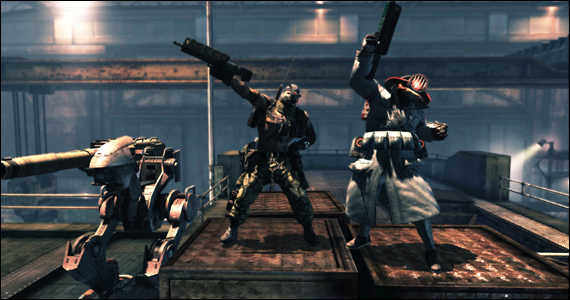
Whether you’re a fan from Lost Planet: Extreme Condition or a new player drawn in by videos of clashing mechs and monsters, response to Lost Planet 2 probably has left you hesitant to render any sort of purchasing decision. I am here to offer you some relief: I can tell you that the calculation can be refined to one variable. That is, precisely how much suffering are you prepared to endure for tremendous action?
The first thing we’re going to do is talk about the controls, because the controls are what the cool kids talk about when it comes to Lost Planet. You may hear that they are clumsy or awkward. The opposite is true: the controls of Lost Planet 2 are perhaps too precise, maybe punishingly so. This is, of course, a Japanese game: the imperative is to destroy you for your failures. Like its predecessor, the game contains a feature unique in the industry: realistic jumping. You are not the Master Chief, blasting off with some mysterious anti-gravity power. No, you command a human character, in a world where gravity functions in a relatable way, and there is a consequence for attempting to defy it. The jump becomes a tactical maneuver rather than a casual affair; you execute it when you are prepared to deal with the fallout.
Yes, Lost Planet 2 offers no mercy for your mistakes. You will be knocked back, control wrenched from you, and be helpless. Understand that this is not a design oversight; it is the developer’s goal that you be trapped in knockdown loop. Later, you will scramble away from enemy fire, cursing the regeneration delay that will inevitably mean your death. You’ll scream at enemies who interrupt your grenade toss with their weapon fire. You may become infuriated and intone deeply regrettable things about the design of this game, but the message is clear: “Bring your A-game, or go home.” Through rigorous training and brutal failures, you will learn not to fail. Or you may simply ragequit.
You may approach these startling realities and feel a sudden wave of fear and loathing. Players are accustomed to navigating an assault rifle on wheels, impervious to environmental concerns, rolling across the terrain and interacting with the world only with the liberal application of bullets. Make no mistake: weapon fire is a fine endeavor, and one I fully support—but surely there must be superior designs for interaction. It seems ludicrous that players feel entitled to sprint alongside exploding grenades without missing a step, or cut a path across the quaking earth and not stumble. When your character becomes more than a set of wheels and the terrain more than a plane for him to barrel across, you are being afforded a new way to touch the world that doesn’t depend on your assault rifle. Embrace it! It won’t hurt you! You’ll adapt.
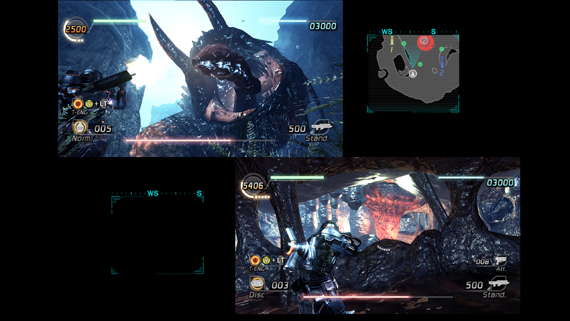
The campaign is substantial, and offers two player split screen and or four player online co-op. It is possible to play alone, but it’s more honest to say that there is no single player at all—the game does not so much feature single player as it allows it. The game requires you to specifically set an “Offline” option to play alone, which suggests not a single player mode, but a co-op campaign with the bonus option to play by yourself. If you do venture forth under this condition, or if you’re unfortunate enough to lose your squadmates during a co-op match, it will become immediately apparent that alone is not the way to play Lost Planet 2. Abysmal AI coupled with staggering difficulty makes any single player venture an exercise in masochism, and defies the real strength of the game.
The claim to fame of Extreme Condition was dynamic combat, and that returns here largely unchanged; only magnified for every human player you carry with you. Somehow, grappling onto the backside of a horrible alien monstrosity to unload your clip into its carapace becomes infinitely more exciting when you aren’t the only one hanging on for dear life.
The frantic, hyperkinetic, large scale battles are wonderfully mutated by the addition of co-op; you’ll see even more of those beautiful explosions as your allies fire from all sides and from all heights. Players scramble across the terrain, vaulting up sheer walls with their grapples, unloading a storm of shrapnel with oversized mech-shotguns, and screaming across the battlefield in lumbering vital suits. This is where Lost Planet 2 breaks out of its chains and delivers to the player its true product: the chaotic science of the battle.
Combat from Extreme Condition has seen a few refinements, the most immediately gratifying being the ability to repair damaged vital suits at the cost of thermal energy. Players are now required to kick-start their regeneration manually, making your struggle to remain standing a little more frantic, but this is offset by the ability to share thermal energy among your squad—meaning you’ll rarely be left out in the cold.
As with the original, where you are shooting and where you are running are not co-dependent; you can shoot in any direction while running in any other, allowing for the ultimate execution of the circle strafe tactic. The anchor returns and remains highly useful for navigation, occasionally useful for combat, and reliably entertaining at all times. New is the sprint feature, which you will immediately learn is not designed to charge your enemies with.
You’ll be afforded an impressively expanded suite of weapons; there’s something for every occasion and every player, whether you prefer to finish the fight on foot or in a vital suit. The variety here can be staggering, and the game builds upon perhaps the greatest strength of Extreme Condition. There’s no wrong way to fight your war, and with such a wide canvas upon which to design your battle, you will invariably find satisfaction.
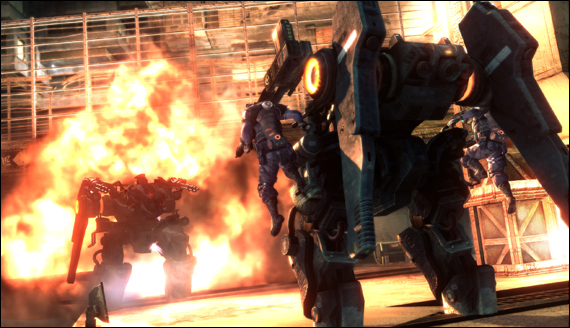
Visually, however, the game is a mess. Character designs are interesting, but models look terrible up close, and the face is the exception to the games otherwise superior animation: that is to say, the face doesn’t have any animation. As you notice the painted-on eyes (and you will notice), you may feel as if you have suddenly been transported to 2001. Rest-assured: you are not playing an N64 game. On the plus side, Lost Planet 2 runs without a hitch, and this is no trivial matter with action on this scale. Vital suits look great and the visual design of the mechs and monsters is top notch.
Environments are varied, but you may feel as if you’re moving from a green mess to a brown mess. It can be difficult to discern details, which compounds the already clumsy level design. The culmination of this problem is that you will regularly be separated from your team. You may find that by the time you catch up to your allies, they are already waiting at the exit, having completed the mission without you. You may discover some curious pacing problems; during missions and even during boss battles, it may seem as if the game is cutting you a break and giving you some downtime to navigate the assorted design flaws.
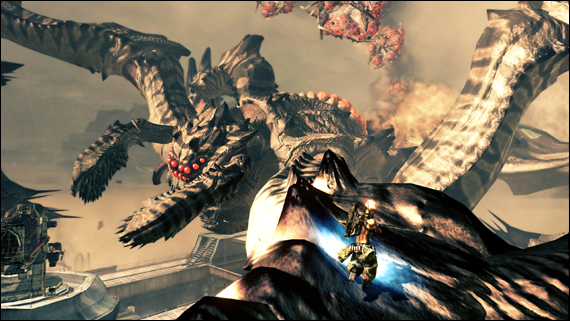
Lost Planet 2’s principle failure is with communication: the game may as well be speaking to you in another language, when it bothers to speak at all. Objectives are rarely clear, and though you will receive mission updates from various disembodied voices, they often occur while you fight for your life, and are missed accordingly. Way-finding is a disaster; the level path is never clear, objectives are poorly marked, and the mini-map is nigh-useless. Worse, however, is that the game squanders some of its best moments by not communicating to the player how to play them. One sequence requires the squad to load, aim, and operate a massive cannon mounted atop a moving train. Make no mistake: this makes for great fun once you’ve deduced the method behind the madness, but the game slams a roadblock in your way by refusing to communicate what it is you’re supposed to do. There is an argument for requiring players to puzzle out the solution in such battles, but as you stand around stupidly with the boss battle occurring somewhere on your periphery, you’ll perceive that this is not the case here.
AI lacks to the point of offense. Friendly NPCs will sit in the spare seats of your mech, but may never fire their weapons. On rare occasions, enemy soldiers may gaze right at you, follow you with their weapons, but fail to attack. During missions requiring complex behaviours—specifically, boss battles—the friendly characters cannot be depended upon to do any fighting, much less perform any necessary tasks. During the railway cannon sequence, my computerized squadmates felt the best course of action was to stand, unmoving, at the back of the train. That, halfway through the battle, they eventually began to load shells was little consolation as the raging monster obliterated the team.
Veterans of Lost Planet: Extreme Condition, though, will be happy to learn that they will be afforded some relief from the abysmal and lengthy storytelling of the first game, but know that you aren’t out of the woods quite yet. The game occurs in episodes depicting the various factions battling for control of the planet’s thermal energy—and though the cutscenes are shorter and few in number, you will quickly tire of them as it becomes apparent that “Factions battling for thermal energy” represents the sum of information you will ever be able to gleam from the narrative. As the story continues, it becomes apparent that the vague references you expected to be explained later will never appear again, and that though the dialogue creates an air of mystery, you will never be entirely certain of what the mystery is, much less its resolution. As the characters pontificate on the matter of the somehow deeply important Cat-G Akrid and the apparently temperamental temperature of the planet, I came to a gradual realization: you’re never going to explain any of this, are you? This is going to be like Lost, but without the great characters.
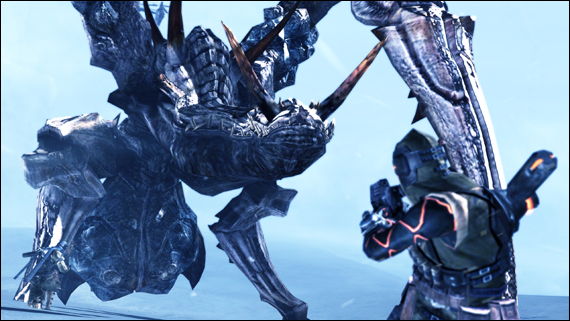
When you’re finished with the campaign, you’ll find a comprehensive multiplayer component. The learning curve is steep; this is not like any game you’ve played, and there has not been much work done towards balancing for new players. Be prepared to be dispatched by more experienced and better equipped players as you learn the ropes. The rule from the campaign persists in the multiplayer, and that is that you will find fun so long as you’re willing to suffer to get there. If you do persist, there’s an impressive number of customization options and unlockables, though you may become frustrated with the asinine method for acquiring them, which usually affords you a slew of new titles rather than anything of value.
Lost Planet 2 is flawed, and it will frustrate you. Critical to your enjoyment of the game will be the ability to discern when the error is in the game design, and when the error is in your hands. If you have the endurance to surmount both, you’ll be rewarded an exceptional combat mechanic and thrilling set pieces. If not, nobody will think any less of you for hurling your controller across the room.
Lost Planet 2
Developer – Capcom
Publisher – Capcom
System – PlayStation 3, Xbox 360, Microsoft Windows (PlayStation 3 Reviewed)
Release Date – May 11, 2010
*A copy of this title was provided by the publisher for review
See I’m still torn. All the reviews say what you said about the “single player” or lack there of… but the Milkman has assured me that “single player” is fine! I had this game on pre-order since it was announced only to cancel at the last minute due to the reviews of the “single player” because that is how I like to play my games and I loved the first game. I think I’m still going to wait for a bigger price drop… :\
Comment by Ujn Hunter — June 12, 2010 @ 7:16 pm
I haven’t spent as much time with it as Brad, but I was almost ready to say that single-player wasn’t as bad as I’d heard – except there are just some points where what you need to do is so not easy to grasp readily, and the AI makes no effort to help move that along, and in those situations the two worked together to really stall me out.
Up until stuff like that, there are times where I was running through the jungle and a sense of teamwork thinly existed, or I was just having fun blasting crazy akrid.
Comment by Jamie Love — June 12, 2010 @ 9:08 pm